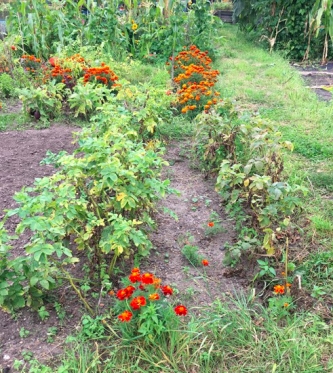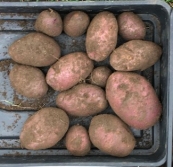Last year the tomatoes were an amazing success. This year, more than a bit of a failure. Warnings about blight have been all over the allotment blogs for a couple weeks. With the very wet and rainy weather this August it was only a matter of time before the outdoor tomatoes succumbed.
Over the past couple of weeks I’ve been digging up the tomato plants. It is never a good idea to compost infected material, so I’ve been dragging bags of plant carcasses home to dispose of with the regular trash. The outdoor tomatoes in the middle of the plot were the first to go. I thought all was not lost, as I had some random plants that scattered here and there that were slightly less exposed to the wind. This proved hopelessly optimistic as they lasted only a week longer than the others. Fingers crossed for the indoor tomatoes. However, they are rather foolishly hanging their heads out the greenhouse window. I would not be at all surprised by their imminent demise.
At least there are some lessons to be learned from this debacle. First up, I can report favorably on the performance of the Crimson Crush F1s. These are a new-ish offering advertised as having blight resistance. I find that they do indeed do show good resistance to blight and are also rather tasty. They are more on the sweet side as opposed to tart, but quite nice nonetheless. There are a few patches of blight on the stems, but so far the fruits have survived unblemished. These have definitely earned a place on the “plants that I grow every year” list. There isn’t an official list, yet, but there soon will be. Watch this space. Digression aside, I will grow Crimson Crush next year, but they are rather expensive (£3.99 for 10 seeds) and I am a bit of a tightwad who does not enjoy spending money. They are F1s, so saving seed is a bit pointless as the progeny won’t resemble their parents. I might instead try to make them go a bit further by turning the tomato armpits into new plants.
Speaking of tomato armpits, it is evident that these plants are not exactly laden with lovely fruits, and eagle-eyed gardeners may have noticed that the plants were not pruned properly. This is because The Enabler, despite holding an advanced degree in science, was unable to follow instructions on how to prune tomato plants. It’s too late in the season to take proper pictures, so pictures of my fingers will have to do.
Imagine that my thumb is a leaf shoot and  pruning my middle finger is the stem. The side shoot is my index finger, which many gardening gurus advise you to pinch out if your tomato is an indeterminate/cordon variety. With bush or determinate tomatoes, the size to which the plant grows is limited, so the side shoot can stay without fear of the plant becoming overstretched. The theory is that you will have better yields if the plant focuses its energy on five to seven fruit-bearing trusses. If the suckers are left on they will drain energy from the mother plant as they attempt to become proper adult (but never fully independent) full-grown plants. The result – an overgrown plant that doesn’t produce lots of tomatoes.
pruning my middle finger is the stem. The side shoot is my index finger, which many gardening gurus advise you to pinch out if your tomato is an indeterminate/cordon variety. With bush or determinate tomatoes, the size to which the plant grows is limited, so the side shoot can stay without fear of the plant becoming overstretched. The theory is that you will have better yields if the plant focuses its energy on five to seven fruit-bearing trusses. If the suckers are left on they will drain energy from the mother plant as they attempt to become proper adult (but never fully independent) full-grown plants. The result – an overgrown plant that doesn’t produce lots of tomatoes.
According to the internet, many gardeners do have success growing tomatoes despite having not known about tomato pruning. Others take rather sophisticated approaches that are possibly best left to people who actually know what they are doing. At Plot 4, we’ve not tried the no-prune approach or any of the more complicated methods, but somebody (not me) inadvertently experimented with removing ALL THE LEAF shoots sometime around June whilst leaving all of the side shoots intact. This is definitely a crap idea. While it is recommended to progressively remove the lower leaves later in the season to improve airflow and decrease the chances of blight, early in the season the plant needs these leaves for photosynthesis. Cutting them off too early decreases the plant’s energy when it kind of needs it. On top of that, all of the suckers were systematically left intact, spreading the plants now limited resources rather thin. The result – a rather sickly plant that did not produce many tomatoes.
There is one final learning opportunity to be gleaned from my blight woes. Rather foolishly I planted my potatoes right next to my tomatoes. I had already dug up my first and second earlies but the mains were still in the ground when the blight struck.  However, I was inadvertently clever and chose two varieties with varying levels of blight resistance! On the left is one row of Cara, which are meant to have complete blight resistance. So far they look good, with the foliage still in decent shape for September. Hopefully it will continue to feed the tubers below for another few weeks or so. To the right of them are Sarpo Blue Danube. These can get blight on the leaves but the tubers should remain unaffected. The leaves were already on the turn when the tomatoes went down, but so far there has been no obvious sign of blight.
However, I was inadvertently clever and chose two varieties with varying levels of blight resistance! On the left is one row of Cara, which are meant to have complete blight resistance. So far they look good, with the foliage still in decent shape for September. Hopefully it will continue to feed the tubers below for another few weeks or so. To the right of them are Sarpo Blue Danube. These can get blight on the leaves but the tubers should remain unaffected. The leaves were already on the turn when the tomatoes went down, but so far there has been no obvious sign of blight.
The leaves on one plant have now completely died back, so I had a go at digging it up. The good news is that there was a decent harvest from one plant with no evidence of blight on the potatoes! The bad news is that this variety makes excellent potato wedges. My waistline won’t thank me.
died back, so I had a go at digging it up. The good news is that there was a decent harvest from one plant with no evidence of blight on the potatoes! The bad news is that this variety makes excellent potato wedges. My waistline won’t thank me.







An interesting post. I sympathise as my site invariably gets blight towards the end of August, and sure enough the tomatoes got affected a week ago. It didn’t help that any taking out side shoots was minimal so they got very jungle like which doesn’t help. Good air circulation is supposed to help.
It’s perhaps worth trying early fruiting varieties such as Golden Sunrise and Outdoor Girl if growing outside in areas which get blight most years.
I would keep an eye on all the potato foliage and cut back to ground level at the first sign of them being affected. You can then leave the tubers a couple of weeks before lifting.
And next year make sure you plant the two as far apart as you can. xx
LikeLike
We had been lucky that past two summers, but looks like that luck has run out. Thanks for the suggestion re early varieties. I had not heard of those, but will definitely give them a go next year!
So far the potatoes look ok, but will definitely be watching them. Also, we will discard or burn the foliage regardless, just to be on the safe side…
LikeLiked by 1 person
Tomato Armpits! Love it.Funny how our dog can smell just like that.Lol.
Looks like you will be buying your tomato sauce this year.Better luck
next year.Enjoy your potato wedges.lots of vitamins and 0 calories.
Ok the 0 calorie part i made it up. Fake news knows no boundaries!
LikeLike
But they are cooked in lots of olive oil and olive oil is supposed to be good for you, so lots of it must be really good for you, no? If only…
LikeLike